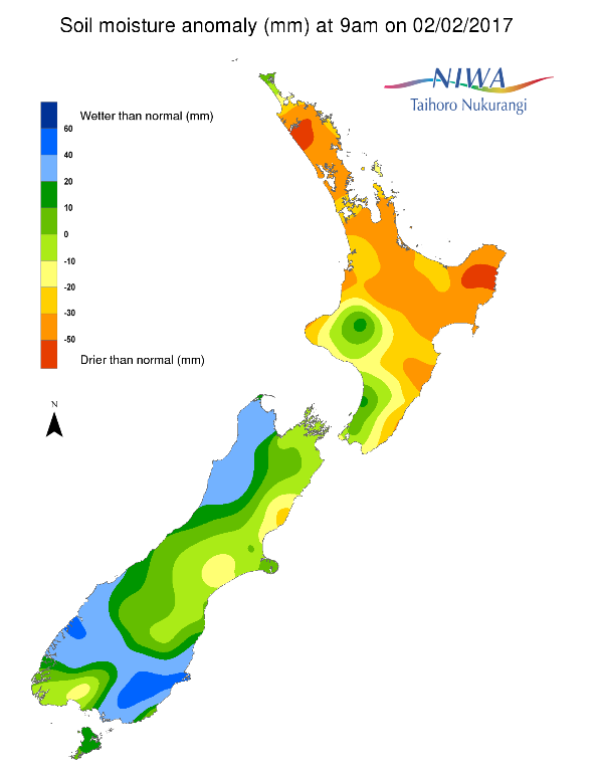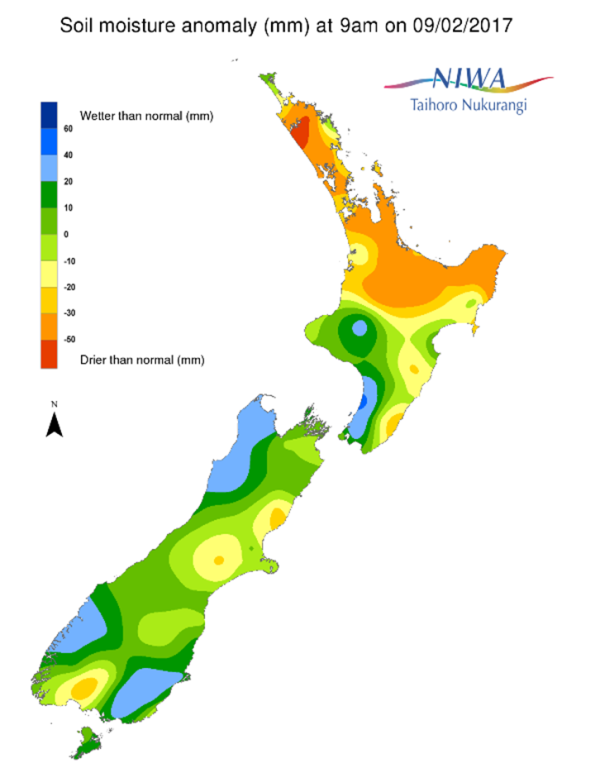A weekly update describing soil moisture across the country to help assess whether severely to extremely dry conditions are occurring or imminent. Regions experiencing these soil moisture deficits are deemed “hotspots”. Persistent hotspot regions have the potential to develop into drought.
Facts: soil moisture
Across the North Island, soil moisture levels have generally increased during the past week in southern areas, while soil moisture levels have remained approximately the same as last week in the northern half of the island. The most substantial decreases were observed in central Bay of Plenty and northern Coromandel Peninsula, while the most substantial increases occurred in Taranaki, Manawatu-Wanganui, Hawke’s Bay, Gisborne, and western Wellington. Smaller increases were also observed in eastern Northland and western Waikato. The driest soils across the North Island compared to normal for this time of the year are found in western Northland, while the wettest soils for this time of the year are found along the Kapiti Coast.
Hotspots remain in place across much of the northern North Island, including most of Northland, Auckland, northern and central Waikato, the Bay of Plenty, and Gisborne. Small hotspots also persist on the Mahia Peninsula and in coastal Wairarapa. In all of these areas soils continue to be severely to extremely drier than normal for this time of year. In addition, the Ministry for Primary Industries has classified the dry soils in Northland as a medium scale adverse event. Conversely, the hotspot formerly located across Hawke’s Bay and the Tararua district has now dissipated due to substantial rainfall this week.
Across the South Island, soil moisture levels have generally decreased by small amounts during the past week. Modest decreases were observed across Southland, Otago, and southern and central Canterbury during the past week. Meanwhile, minor increases occurred in Nelson, southern Marlborough, and the Kaikoura district.
A small hotspot remains in place in coastal Hurunui district, along with another small hotspot that has developed in central Selwyn district.
Outlook and soil moisture
For the North Island, substantial rainfall of 20-40 mm fell in eastern Northland earlier today, although this has not yet been fully incorporated into the soil moisture anomaly map below. Dry weather is expected on Friday and Saturday before a few showers reach western parts of the North Island on Sunday and Monday (12th-13th February), producing generally 10 mm or less. A few more substantial showers are possible on Tuesday from Taranaki to Wellington, with up to 15 mm possible. High pressure will then bring a return to dry weather for the middle of next week.
With the expected rainfall during the next week, soil moisture levels will likely change little in western areas from Taranaki to Wellington, although today’s rainfall in eastern Northland will lead to improved soil moisture levels there. However, the majority of the North Island will see meagre rainfall during the next week, which will strengthen the ongoing hotspots in northern, central, and eastern areas. Although the hotspot in Hawke’s Bay and Tararua dissipated this week, it will likely return in the coming days due to low rainfall amounts.
For the South Island, showers will move across the West Coast and Southland on Friday, producing generally 15 mm or less. After mostly dry weather on Saturday, showers will return to the West Coast on Sunday (12th February). A storm will bring more substantial rain to the West Coast, Southland, and Otago from Monday into Tuesday, with up to 50 mm possible along the West Coast, and up to 25 mm in Southland and Otago. Mostly dry weather will return to the South Island by the middle of next week.
Heavy rainfall will likely lead to increased soil moisture levels along the West Coast in the next week, while smaller increases may also occur in Southland and Otago. Meanwhile, light rainfall in the next week will likely lead to decreasing soil moisture levels across Marlborough and Canterbury. The hotspot in the Hurunui district will likely strengthen in the next week, and it may expand farther south into central Canterbury as well.
Background
Hotspot Watch a weekly advisory service for New Zealand media. It provides soil moisture and precipitation measurements around the country to help assess whether extremely dry conditions are imminent.
Soil moisture deficit: the amount of water needed to bring the soil moisture content back to field capacity, which is the maximum amount of water the soil can hold.
Soil moisture anomaly: the difference between the historical normal soil moisture deficit (or surplus) for a given time of year and actual soil moisture deficits.
Definitions: “Extremely” and “severely” dry soils are based on a combination of the current soil moisture status and the difference from normal soil moisture (see soil moisture maps)


